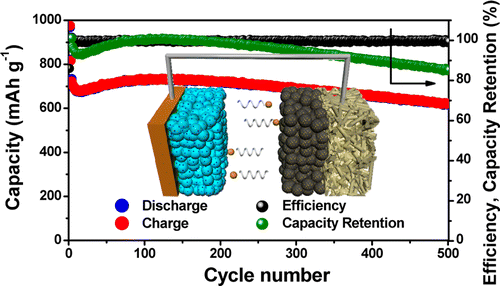Lithium-sulfur batteries have been off-stage hopefuls, waiting for their chance to strut their stuff – and that time may have arrived, at least in trial performances. Researchers at the Department of WCU Energy Engineering, Hanyang University in South Korea and the Department of Chemistry at the University of Rome, Italy have “demonstrated a highly reliable lithium–sulfur battery showing cycle performance comparable to that of commercially available lithium-ion batteries while offering more than double the energy density.”
The team, led by a group from Hanyang University, designed a lithium-sulfur cell using “a highly reversible dual-type sulfur cathode (solid sulfur electrode and polysulfide catholyte) and a lithiated Si/SiOx nanosphere anode.”
Their paper in the ACS journal Nano Letters reported that their cell showed “superior battery performance in terms of high specific capacity, excellent charge–discharge efficiency, and remarkable cycle life,” The cell delivered ∼750 mAh g–1 over 500 cycles (85-percent of the initial capacity).
Researchers suggested these “behaviors” may result from “a synergistic effect of the enhanced electrochemical performance of the newly designed anode and the optimized layout of the cathode.”
Battery makers such as Sion Power and Saft, have developed commercially-viable lithium-sulfur batteries, but not with energy densities competitive with lithium-ion to this point. Lithium-sulfur does offer promise, however, with the low cost of sulfur (partly from its abundance) and high theoretical energy density. Hanyang and University of Rome see numbers of sulfur-based cathodes of 1,675 milliamps per gram and 2,500 Watt-hours per kilogram, both exceeding those for lithium-ion units.
Researchers had to overcome at least two issues presented by lithium-sulfur batteries, “low active material utilization, and low stability of the sulfur electrodes due to the formation of soluble lithium polysulfides during cell operation.” Fighting fire with fire (not a reasonable approach in battery development normally) the team added lithium polysulfide to the battery’s electrolyte to improve cycle performance and energy density.
The abstract for their Nano Letters paper gives a few of the reasons for the battery’s superior performance. “Lithium–sulfur batteries could become an excellent alternative to replace the currently used lithium-ion batteries due to their higher energy density and lower production cost; however, commercialization of lithium–sulfur batteries has so far been limited due to the cyclability problems associated with both the sulfur cathode and the lithium–metal anode. Herein, we demonstrate a highly reliable lithium–sulfur battery showing cycle performance comparable to that of lithium-ion batteries; our design uses a highly reversible dual-type sulfur cathode (solid sulfur electrode and polysulfide catholyte) and a lithiated Si/SiOx nanosphere anode. Our lithium–sulfur cell shows superior battery performance in terms of high specific capacity, excellent charge–discharge efficiency, and remarkable cycle life, delivering a specific capacity of ~750 mAh g–1 over 500 cycles (85% of the initial capacity). These promising behaviors may arise from a synergistic effect of the enhanced electrochemical performance of the newly designed anode and the optimized layout of the cathode.”
The paper, “Highly Cyclable Lithium–Sulfur Batteries with a Dual-Type Sulfur Cathode and a Lithiated Si/SiOx Nanosphere Anode,” by authors Sang-Kyu Lee, Seung-Min Oh, Eunjun Park, Bruno Scrosati, Jusef Hassoun, Min-Sik Park, Young-Jun Kim, Hansu Kim, Ilias Belharouak, and Yang-Kook Sun was published in Nano Letters this month.
Many of the same researchers performed related work on a polysulfide-added electrolyte as a buffer to prevent cathode dissolution. Their full paper on that research can be seen here.
The abstract for their Nano Letters paper gives a few of the reasons for the battery’s superior performance. “Lithium–sulfur batteries could become an excellent alternative to replace the currently used lithium-ion batteries due to their higher energy density and lower production cost; however, commercialization of lithium–sulfur batteries has so far been limited due to the cyclability problems associated with both the sulfur cathode and the lithium–metal anode. Herein, we demonstrate a highly reliable lithium–sulfur battery showing cycle performance comparable to that of lithium-ion batteries; our design uses a highly reversible dual-type sulfur cathode (solid sulfur electrode and polysulfide catholyte) and a lithiated Si/SiOx nanosphere anode. Our lithium–sulfur cell shows superior battery performance in terms of high specific capacity, excellent charge–discharge efficiency, and remarkable cycle life, delivering a specific capacity of ∼750 mAh g–1 over 500 cycles (85% of the initial capacity). These promising behaviors may arise from a synergistic effect of the enhanced electrochemical performance of the newly designed anode and the optimized layout of the cathode.”

